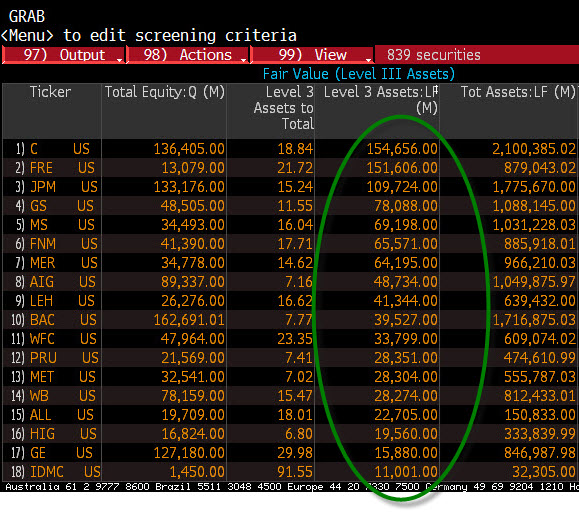Every possible effort is being made to make our banks healthier. And if that is not possible, then to at least make them appear healthier. The SEC just passed a new rule with this second aim in mind.
And I’m not sure how much it is really going to do, since the rule change will allow companies to place higher values on stricken assets that have already been "marked down." As I point out below, many companies have not yet done this, so how much of a gain will result is questionable.
Here is an excellent article on the rule change.
[quote]Some economists are attributing much of the current financial crisis to something as mundane-seeming as accounting.
The Securities and Exchange Commission and the Financial Accounting Standards Board have just made an announcement that, dry as it sounds, may mean a great deal: "When an active market for a security does not exist, the use of management estimates that incorporate current market participant expectations of future cash flows, and include appropriate risk premiums, is acceptable."
There is no market right now for the worthless mortgage-backed securities — that’s one of the reasons we’re in this crisis. That means financial institutions that are holding them must value them at zero, or near to it. That makes the institutions themselves worth much less.
The SEC has just said that the financial institutions themselves can now place a fair value on the assets. That could raise a whole other set of issues, but for now, let’s just deal with this one.
Accounting is not something that ordinary taxpayers think about much, but it could hardly be more important to businesses: It’s the value they place on what they own, what they owe and what they can sell.
An odd-sounding accounting phrase at the heart of this is something called "mark-to-market" accounting. Many think that if this requirement were ended, the crises could be eased.
Simply put, mark-to-market accounting requires companies to set the value for the assets they own at the price they could fetch on the open market right now. The prices must be "marked to market;" hence the phrase.
What does that have to do with the current crisis? The root problem now is that financial institutions have been caught holding value-less, or "toxic," assets on their books, such as the mortgage-backed securities based on sub-prime mortgages that have defaulted.
The government believes that those assets will be worth something soon — that’s why they want to buy them in the $700 billion Wall Street rescue plan. But under mark-to-market rules currently required, they are worth almost nothing, threatening those who hold them with insolvency.
If the holders could place a value on the assets equal to the estimated value they should bring in the future, suddenly the balance sheets of these financial institutions would look a lot healthier.[/quote]
Now, if lots of companies had taken their assets and put them through the mark-to-market wringer, they could potentially reverse that process and now record those paper gains on their books.
However, instead of "marking-to-market," many companies opted instead to park their troubled assets off into another arcane accounting cul-de-sac called "Level III" assets.
Definition of Level III:
Assets whose fair value cannot be determined by using observable
measures, such as market prices or models. Level III assets are typically
very illiquid, and fair values can only be calculated using management estimates
or risk-adjusted value ranges.
Here’s a snapshot of some financial companies and their Level III asset counts from August. Clearly, as you scan the list you will note that several of those companies are notably absent from the September landscape.
Numbers are in millions (meaning, for example, that Citibank has $154.6 billion in level III assets).

This new SEC rule change is specifically targeted at the remaining members of this list, especially those at the top. Just for fun, compare the total equity of the organizations (the first column of numbers) to their Level III assets, and you can see why there is great concern that these Level III assets not be marked to their current market value (presently ‘zero’ for many).
I don’t know for sure how much this new rule change will help; that depends on how many companies already announced writedowns that can be reversed now. My only point here is that companies with large Level III asset pools have already been hiding the dirt deep in their balance sheets, carrying them at "management estimates."
The SEC rule change will almost certainly not allow Level III assets to be valued any higher than they already are. So, no big change on that front.


